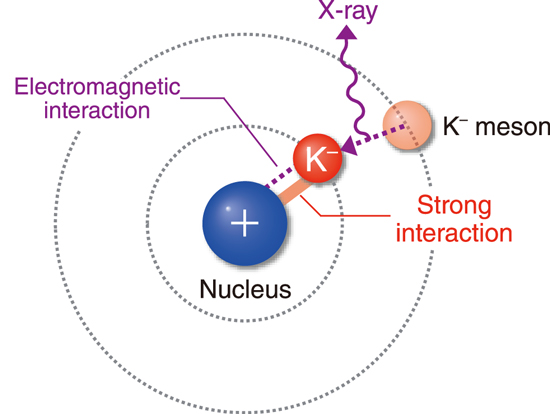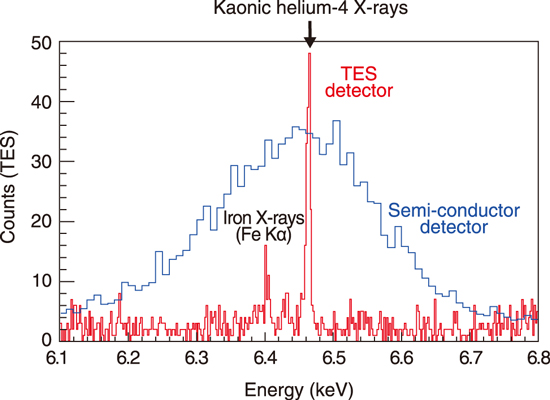
Fig.3-4 Diagram of a kaonic atom

Fig.3-5 X-ray spectra of 3d→2p transitions in kaonic helium-4 atoms
A kaonic atom is a system of a K- meson and nucleus bound by electromagnetic interaction (Fig.3-4). We can study the strong interaction between a K- meson and nucleus by measuring the X-rays emitted by kaonic atoms. Along with investigations of other particles with strange quarks, such as Λ particles, studies on K- mesons will play an important role in elucidating the internal structure of neutron stars.
So far, the X-ray spectroscopy of kaonic atoms has suffered from the limited intensity of the K- beam and the lack of X-ray detectors that can achieve both excellent energy resolution and good detection efficiency. We used the high-intensity K- beam supplied by the J-PARC Hadron Experimental Facility to produce many kaonic atoms. The X-rays were then measured using superconducting transition-edge-sensor (TES) microcalorimeters.
The TES detector is a cryogenic detector with high energy resolution. It utilizes a rapid change in electrical resistance in a small temperature range at superconducting transition. Although a single pixel should be kept small for good resolution, a multipixel array realizes a reasonably large effective area. In this work, we used this detector at a charged-particle beamline for the first time. The K- beamlines are particularly harsh environments for a high-sensitivity sensor as they contain many background particles such as π- mesons. We successfully performed the X-ray measurement of kaonic atoms with excellent energy resolution by minimizing the background particles incident on the detector and removing their effects during signal analysis (Fig.3-5).
We determined the energy shift due to the strong interaction in the 2p orbitals of kaonic helium-3 and helium-4 atoms, with about 10 times better accuracy than the previous measurements. This result provides a strong constraint on how attractive the strong interaction between the K- meson and the nucleus is. With further X-ray measurements of other kaonic atoms and studies of recently discovered nuclear systems containing a K- meson, we wish to reveal more details about the strong interaction of K- mesons and how K- mesons affect the properties of neutron stars.
This work was supported by JSPS KAKENHI Grant-in-Aid for Scientific Research (A) (JP16H02190) and MEXT Leading Initiative for Excellent Young Researchers Grant.
(Tadashi Hashimoto)